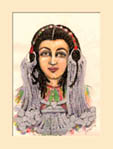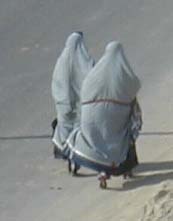 |
Culture.

|

|
 |
SIWA CULTURE
Food
Most Siwan dishes are easy to prepare and made
with fresh ingredients found in the gardens or the market.
Lunch is the main meal of the day, and typically includes
salad, rice or macarona, olives, and a vegetable dish. Meat is
almost always accompanied by a light and flavorful soup made
from its broth. Lighter fare is served at dinner, such as an
assortment of cheese, tomatoes or cucumbers, molasses, and
fried potatoes or eggplant. Foul and felafel or cheese might
be served with hot milk or tea at breakfast. Below are some of
the more common dishes served at home:
Kibda – “Kibda” simply means
“liver” in Arabic, and is served in other parts of Egypt
as well. Chicken liver is sometimes included in soup or
macarona, but sheep liver is usually served as a main dish.
Kibda can be prepared several ways: sauteed in olive oil with
salt; in a spicy tomato sauce; or as shakshouka (see
“Shakshouka”).
Leedam – These are simply mixed
vegetables cooked in a tomato base with onion, coriander,
salt, hot pepper, and sometimes garlic. Chicken or lamb broth
is usually added for flavor. Peas, carrots, zucchini
(courgette), potatoes, eggplant or pumpkin are all possible
depending on what looks good that day at the market. It is
served with rice.
Lefroosh – Sheep’s stomach
is cut and tied with intestine into little packets, which are
boiled to make a broth. Onion, tomato sauce, coriander and hot
green peppers are added to flavor the broth, and the entire
dish is served either with rice or macarona. Sometimes
lefroosh is cooked in silk or molokhiya.
Macarona – Siwan macarona is
similar to spaghetti, but the pasta is cooked in the sauce and
coriander and cumin are used instead of oregano or basil. The
different spices lend it a refreshingly different
flavor.
Makhmakh – In Arabic, this leaf is known as
“rigl,” but Egyptians are not likely to know what it is.
The small leaves of this plant are chopped and cooked in a
broth to which ground tomatoes, lentils and hot pepper are
added. The result is similar to molokhiya, but the flavor is
milder and the dish itself is thicker in consistency. Look for
makhmakh when it is in season during the warmer months. Unlike
molokhiya, it is only prepared fresh, never from dried
leaves.
Molokhiya – Known in English as
“Jew’s Mallow”, molokhiya is common throughout Egypt but
grows quite high in Siwa. It resembles spinach in taste and
appearance, but is always served as a dip eaten with bread.
The finely chopped leaves are cooked in broth; pureed tomato
and a mixture of ground garlic, hot pepper and coriander are
added for flavor.
Reearin – This dish is only found in Siwa, and is a
dip made of lentils cooked with molochiya and hot green
pepper. Siwan olive oil is usually drizzled over the top. A
complete Siwan meal would include reearin, a plate of olives,
and bread.
Shakshouka – Minced chicken or sheep liver is
sauteed with tomatoes, onions, coriander, parsley and
cilantro, and ladled into a dish. An egg is cracked over the
top, and the whole dish is baked in an oven until the egg is
cooked. The result is delicious, and can be eaten with bread.
For those who don’t eat meat, some of the local restaurants
will serve shakshouka made from tuna or vegetables. The best
shakshouka, though, is made with sheep liver.
Shorbit – Soup is served with every
meal that includes meat, as the meat is always boiled first
and its broth used to flavor other dishes. Broth might come
from lamb, goat, camel, chicken, liver, or sheep stomach.
Unlike other parts of the world where soup might be thick and
hearty, Siwan soups are light and never eaten on their own.
Typically, a small amount of pasta known as “lisan asfour”
(“sparrow’s tongue”) is first browned in a small amount
of oil. A small amount of ground tomatoes are cooked until
thickened, and then added to the pasta. Finely chopped carrots
and zucchini are added next, followed by broth, salt and
coriander. Just before the soup is served, a pinch of either
mint or dill is sprinkled on top. Soup in Siwa is not eaten
with bread – however, it is sometimes eaten over rice.
Silk – Silk is similar to spinach
and cooked in the same way as makhmakh. The small leaves of
this plant are chopped and cooked in a broth to which ground
tomatoes, lentils and hot pepper are added. Like makhmakh, it
is eaten with bread.
Dishes for Special Occasions
Food is always tied to special occasions in Siwa, and
for women, cooking is part of the celebration. Macarona and
chicken are served for most large gatherings, but some other
special dishes are still prepared:
Ashengoot – Roast duck or chicken wrapped in a crepe
called “roqaq.” Usually at gatherings the bird is roasted
whole, and then presented with the roqaq to one of the guests,
who then carves the bird and distributes the pieces wrapped in
roqaq to the other guests.
Engeel – Pita bread baked with
mashed dates kneaded into the dough. Engeel is served to
weddings guests and to the bride on her first morning.
Edsheesh – Crushed wheat cooked in
broth. Edsheesh is always served on the last day of weddings,
bridal showers and other celebrations: when the edsheesh
arrives, everyone knows it is time to go home.
Emjerdig – a large, thinly rolled flat bread that is
dry like a cracker. Huge batches are made during the Siyaha
Festival to be eaten with the special soup,
nesequd.
Libsees – This simple desert is served at holidays
and handed out in packets as a party favor at weddings and
baby showers. There are two kinds, “black” and
“white.” “Black” libsees is made from ground dates,
and “white” libsees is made from ground dry hommos
sweetened with sugar. The white libsees can be mixed with
either water or ghee to make a thick paste, and is eaten with
a spoon.
Menina – During the last week of Ramadan, all the
women in the family gather together at each other’s house to
help make the cookies that will be served on Eid Al Fitr. Many
of the cookies prepared are the same as in other parts of
Egypt: chocolate and vanilla sugar cookies dipped in jam and
coconut; large cookies stuffed with dates (“kahk”); long
twists of sesame flavored cookies. Menina are only made in
Siwa. The dough, made from flour, oil, eggs and sugar, is
pressed flat and then cut into thick squares the size of a
child’s hand. Then traditional designs, many of which are
also used as motifs in henna, are etched onto the cookie with
a knife.
Neseqqud – A soup eaten by all who
attend the Siyaha Festival. Emjerdig, a kind of large cracker,
is crumbled into a camel broth, and lemon juice sprinkled on
top.
Roqaq – A large crepe that is eaten
with poultry, as in ashengood.
Tanqota’t – A hot cereal served to
guests for breakfast during the first three days after the
birth of a baby. It is made of homemade macarona cooked with
fenugreek and served with ghee and sugar.
|
 |